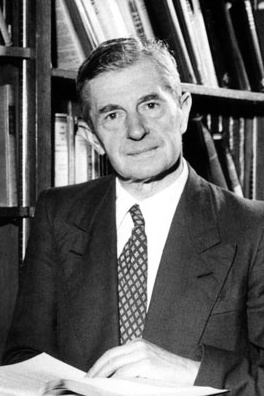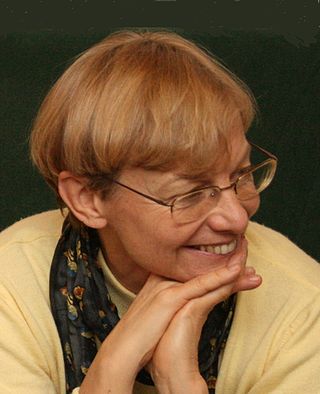Related Research Articles

Sydney Chapman was a British mathematician and geophysicist. His work on the kinetic theory of gases, solar-terrestrial physics, and the Earth's ozone layer has inspired a broad range of research over many decades.

The American Geophysical Union (AGU) is a 501(c)(3) nonprofit organization of Earth, atmospheric, ocean, hydrologic, space, and planetary scientists and enthusiasts that according to their website includes 130,000 people. AGU's activities are focused on the organization and dissemination of scientific information in the interdisciplinary and international fields within the Earth and space sciences. The geophysical sciences involve four fundamental areas: atmospheric and ocean sciences; solid-Earth sciences; hydrologic sciences; and space sciences. The organization's headquarters is located on Florida Avenue in Washington, D.C.

Cluster II is a space mission of the European Space Agency, with NASA participation, to study the Earth's magnetosphere over the course of nearly two solar cycles. The mission is composed of four identical spacecraft flying in a tetrahedral formation. As a replacement for the original Cluster spacecraft which were lost in a launch failure in 1996, the four Cluster II spacecraft were successfully launched in pairs in July and August 2000 onboard two Soyuz-Fregat rockets from Baikonur, Kazakhstan. In February 2011, Cluster II celebrated 10 years of successful scientific operations in space. As of March 2023, its mission has been extended until September 2024. The China National Space Administration/ESA Double Star mission operated alongside Cluster II from 2004 to 2007.

Raymond Jeanloz is a professor of earth and planetary science and of astronomy at the University of California, Berkeley. Educated at the California Institute of Technology, Amherst College and at Deep Springs College, he has contributed research fundamental to understanding of the composition of the Earth and the behavior of materials under high temperatures and pressures. He is working with colleagues to investigate the conditions inside supergiant exoplanets. Jeanloz is also a prominent figure in nuclear weapons policy, chairing the Committee on International Security and Arms Control at the National Academy of Sciences. He was an Annenberg Distinguished Visiting Fellow at Stanford University's Hoover Institution from 2012 to 2013. He is a co-editor of the Annual Review of Earth and Planetary Sciences.
Julius Bartels was a German geophysicist and statistician who made notable contributions to the physics of the Sun and Moon; to geomagnetism and meteorology; and to the physics of the ionosphere. He also made fundamental contributions to statistical methods for geophysics. Bartels was the first President of the International Association of Geomagnetism and Aeronomy (IAGA). With Sydney Chapman, he wrote the influential book Geomagnetism.
Sir Robert Keith O'Nions FRS HonFREng, is a British scientist and ex-President & Rector of Imperial College London. He is the former Director General of the Research Councils UK as well as Professor of the Physics and Chemistry of Minerals and Head of the Department of Earth Sciences at the University of Oxford.
The James B. Macelwane Medal is awarded annually by the American Geophysical Union to three to five early career scientists. It is named after James B. Macelwane, a Jesuit priest and one of the pioneers of seismology. The medal is regarded as the highest honor for young scientists in the field of Geological and Planetary Sciences. In 1984, Mary Hudson became the first woman to receive the award.
Wen Lianxing is a Chinese seismologist and geophysicist. He is a professor at Stony Brook University and the University of Science and Technology of China. He was awarded the James B. Macelwane Medal in 2003 and elected a fellow of the American Geophysical Union.

Jasper A. Vrugt is a Dutch scientist/engineer/applied mathematician known for his work in the earth sciences: surface hydrology, soil physics, hydrogeophysics, hydrometeorology, and geophysics. Vrugt is an assistant professor at the University of California, Irvine and holds a joint appointment in the Department of Civil and Environmental Engineering and the Department of Earth System Science. He also holds a part-time appointment as associate professor at the University of Amsterdam, Faculty of Science (CGE).

Margaret Galland Kivelson is an American space physicist, planetary scientist, and Distinguished Professor Emerita of Space Physics at the University of California, Los Angeles. From 2010 to the present, concurrent with her appointment at UCLA, Kivelson has been a research scientist and scholar at the University of Michigan. Her primary research interests include the magnetospheres of Earth, Jupiter, and Saturn.

Sonia Isabelle Seneviratne is a Swiss climate scientist, professor at the Institute for Atmospheric and Climate Science of the ETH Zurich. She is a specialist of extreme climate events.

Alexander J. Dessler is a space scientist known for conceiving the term heliosphere and for founding the first Space Science Department in the United States.

Barbara A. Romanowicz is a French geophysicist and an expert on imaging the earth's interior.
Maureen D. Long is an observational seismologist studying mantle and Mesosphere dynamics. She currently serves as a professor at Yale University within the Department of Geology and Geophysics.
Rumi Nakamura is an Earth scientist at the Austrian Academy of Sciences. She works on solar-terrestrial interactions, with a particular focus on the terrestrial magnetosphere. Nakamura won the 2014 European Geosciences Union Julius Bartels Medal.

Véronique Dehant is a Belgian geodesist and geophysicist. She specializes in modeling the deformation of the Earth's interior in response to forcing from the Sun, Moon, and the Earth's rotation. She has used similar techniques to study Mercury, Venus, Mars and icy satellites of the outer planets. She primarily works at the Royal Observatory of Belgium, but also serves as an Extraordinary Professor at the Université Catholique de Louvain.
Emily V. Fischer is an Atmospheric Chemist and an Associate Professor in the Department of Atmospheric Science at Colorado State University. She earned notoriety from her work on the WE-CAN project and on PAN, specifically its role in changing the distribution of oxidants in the troposphere. She has received many honors including the prestigious James B. Macelwane Medal which is "given annually to three to five early career scientists in recognition of their significant contributions to Earth and space science." Fischer is also a role model and activist in galvanizing support for women in STEM fields.
Janet G. Luhmann is an American physicist and senior fellow of the Space Sciences Laboratory of the University of California, Berkeley. She has made major contributions to a wide range of topics in planetary, solar, magnetospheric, and heliospheric physics. She is the principal investigator of the IMPACT instrument suite on the twin-spacecraft STEREO mission. IMPACT stands for In-situ Measurements of Particles and Coronal mass ejection (CME) Transients. It consists of a, "suite of seven instruments that samples the 3-D distribution of solar wind plasma electrons, the characteristics of the solar energetic particle (SEP) ions and electrons, and the local vector magnetic field."

Marc Brendan Parlange is an American academic, recognised for his research expertise in environmental fluid mechanics and research in hydrology and climate change. His contributions primarily relate to the measurement and simulation of air movement over complex terrain, with a focus on how atmospheric turbulence dynamics influence urban, agricultural and alpine environments and wind energy. He has also been active in addressing water resources challenges and environmental change in remote communities, particularly West Africa.
References
- ↑ Olsen, E.J. "Dr. Tuija Pulkkinen named next CLaSP department chair". Michigan Engineer News Center. Retrieved 28 August 2019.
- ↑ Baker, Daniel (23 June 1998). "Pulkkinen receives James B. Macelwane Medal". EOS. 79 (25): 293. doi: 10.1029/98EO00219 .
- ↑ Olsen, E.J. "Dr. Tuija Pulkkinen named next CLaSP department chair". Michigan Engineer News Center. Retrieved 28 August 2019.
- ↑ "TUIJA I. PULKKINEN". AGU Honors. American Geophysical Union. Retrieved 28 August 2019.
- ↑ "Members of Finnish Academy of Science and Lett". Finish Academy of Science and Letters. Retrieved 28 August 2019.
- ↑ "Finnish Society of Sciences and Letters Ordinary Members" (PDF). Retrieved 26 October 2022.
- ↑ "Tuija Pulkkinen". National Academy of Science. Retrieved 13 August 2019.
- ↑ "Bartels Medal". European Geosciences Union. Retrieved 13 August 2019.